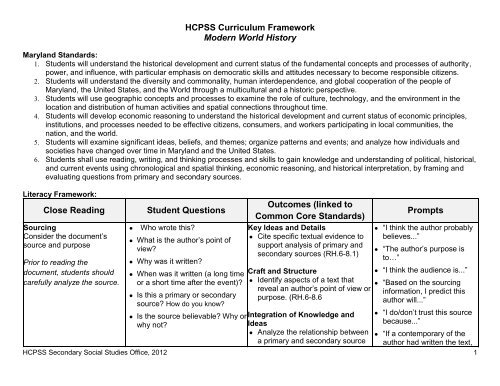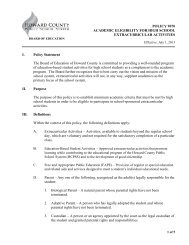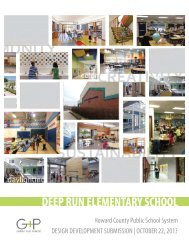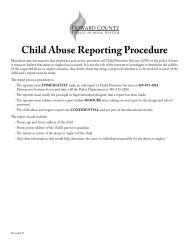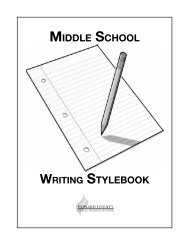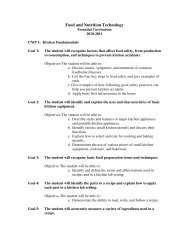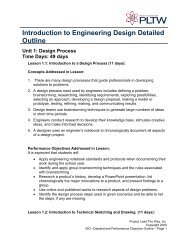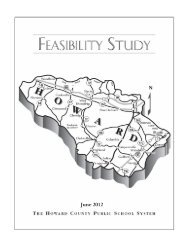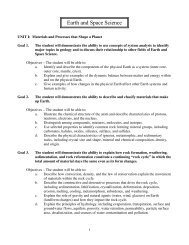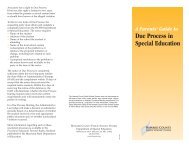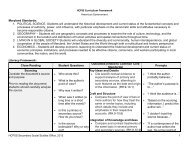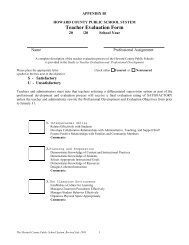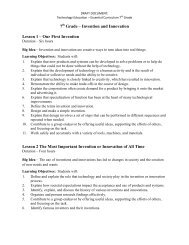Grade 11: Modern World History - Howard County Public Schools
Grade 11: Modern World History - Howard County Public Schools
Grade 11: Modern World History - Howard County Public Schools
Create successful ePaper yourself
Turn your PDF publications into a flip-book with our unique Google optimized e-Paper software.
HCPSS Curriculum Framework<strong>Modern</strong> <strong>World</strong> <strong>History</strong>Maryland Standards:1. Students will understand the historical development and current status of the fundamental concepts and processes of authority,power, and influence, with particular emphasis on democratic skills and attitudes necessary to become responsible citizens.2. Students will understand the diversity and commonality, human interdependence, and global cooperation of the people ofMaryland, the United States, and the <strong>World</strong> through a multicultural and a historic perspective.3. Students will use geographic concepts and processes to examine the role of culture, technology, and the environment in thelocation and distribution of human activities and spatial connections throughout time.4. Students will develop economic reasoning to understand the historical development and current status of economic principles,institutions, and processes needed to be effective citizens, consumers, and workers participating in local communities, thenation, and the world.5. Students will examine significant ideas, beliefs, and themes; organize patterns and events; and analyze how individuals andsocieties have changed over time in Maryland and the United States.6. Students shall use reading, writing, and thinking processes and skills to gain knowledge and understanding of political, historical,and current events using chronological and spatial thinking, economic reasoning, and historical interpretation, by framing andevaluating questions from primary and secondary sources.Literacy Framework:Close ReadingSourcingConsider the document’ssource and purposePrior to reading thedocument, students shouldcarefully analyze the source.●Student QuestionsWho wrote this?● What is the author’s point ofview?● Why was it written?● When was it written (a long timeor a short time after the event)?● Is this a primary or secondarysource? How do you know?Outcomes (linked toCommon Core Standards)Key Ideas and Details● Cite specific textual evidence tosupport analysis of primary andsecondary sources (RH.6-8.1)Craft and Structure● Identify aspects of a text thatreveal an author’s point of view orpurpose. (RH.6-8.6Prompts● “I think the author probablybelieves...”● “The author’s purpose isto…”● “I think the audience is...”● “Based on the sourcinginformation, I predict thisauthor will...”● Is the source believable? Why or Integration of Knowledge and ● “I do/don’t trust this sourcewhy not?Ideasbecause...”● Analyze the relationship between ● “If a contemporary of thea primary and secondary source author had written the text,HCPSS Secondary Social Studies Office, 2012 1
Contextualizing(Imagining/Visualizing thesetting)Place the document in a timeperiod, culture, setting, orsubject-specific contextCritical ReadingRead the text carefully toidentify details and nuancesin the author’s words, or indata, images, text features,etc.HCPSS Curriculum Framework<strong>Modern</strong> <strong>World</strong> <strong>History</strong>● “What events were happening atthe time the text was written?”●●●●●In what ways might thisinfluence what you are reading?What was it like to be alive atthis time?What things were differentduring the time when the textwas written? What things werethe same?What would it be like to see thisevent through the eyes ofsomeone who lived in this time?How might these perspectivesand attitudes influence theiractions?● What claims does the authormake?● What evidence does the authoruse to support those claims?● How is this document supposedto make me feel?● What words does the author useto paint a particular picture of theevent, or to convince me thaton the same topic. (RH.6-8.9)Key Ideas and Details● Determine the central ideas orinformation; provide an accuratesummary of the source distinctfrom prior knowledge or opinions.(RH.6-8.2)Craft and Structure● Identify aspects of a text thatreveal an author’s point of view orpurpose. (RH.6-8.6)Integration of Knowledge andIdeas● Distinguish among fact, opinion,and reasoned judgment in a text.(RH.6-8.8)● Analyze the relationship betweena primary and secondary sourceon the same topic. (RH.6-8.9)Key Ideas and Details● Cite specific textual evidence tosupport analysis of primary andhis or her point of viewwould…”● “I already know that _____is happening at this time...”● “From this document Iwould guess that people atthis time were feeling...”● “This document might notgive me the whole picturebecause...”● “The events of the timewere influenced by…”● “Life during this time periodand life during the 21stcentury are similar and/ordifferent because…”HCPSS Secondary Social Studies Office, 2012 2●secondary sources (RH.6-8.1)Identify key steps in a text’sdescription of a process. (RH.6-8.3)Craft and Structure● Determine the meaning ofwords and phrases as they are●●●●“The author claims that…”“To support his/her claims,the author…”“I think the author chosethese words because theymake me feel…”“The author is trying toconvince me...(byusing/saying...)”
HCPSS Curriculum Framework<strong>Modern</strong> <strong>World</strong> <strong>History</strong>they are right?● What information does the authorleave out?●●used in a text. (RH.6-8.4)Describe how a text presentsinformation (e.g., sequentially,comparatively, causally). (RH.6-8.5)Identify aspects of a text thatreveal an author’s point of viewor purpose (e.g., loadedlanguage, inclusion oravoidance of particular facts)(RH.6-8.6)●●“The ordering of eventsallows readers to...”“Specific vocabulary theauthor uses provides…”Corroborating(Cross-Checking)Compare multiple sourcesagainst each other to developa well supportedinterpretations● What do other pieces ofevidence (texts, images, data,maps, etc.) say?● Am I finding the sameinformation everywhere?● Am I finding different versions ofthe story? (If yes, why might thatbe?)● Where else might I locateadditional information about thetopic?● Which pieces of evidence aremost believable and why?Integration of Knowledge andIdeas● Distinguish among fact,opinion, and reasoned judgmentin a text. (RH.6-8.8)Key Ideas and Details● Cite specific textual evidence tosupport analysis of primary andsecondary sources. (RH.6-8.1)Integration of Knowledge andIdeas● Integrate visual information withother information in print anddigital texts. (RH.6-8.7)● Analyze relationship betweenprimary and secondary sourceson the same topic. (RH.6-8.9)●●“This authoragrees/disagrees with...”“This document waswritten earlier/later thanthe other, so...”HCPSS Secondary Social Studies Office, 2012 3
HCPSS Curriculum Framework<strong>Modern</strong> <strong>World</strong> <strong>History</strong>Universal Design for LearningUniversal Design for Learning is a set of principles for curriculum development and instruction that give all individuals equalopportunities to learn. UDL provides a blueprint for creating instructional goals, methods, materials, and assessments that work foreveryone--not a single, one-size-fits-all solution but rather flexible approaches that can be customized and adjusted for individualneeds.Here are some basic tools to get started with UDL in your classroom:More informationCAST Web-siteGet to know your learners.Online multiple intelligence assessmentExplore classroom technology resources.Discovery Education in the classroomShow Me (Mac and iPad app)Using Edmodo in the classroomPBS Learning Media for Social StudiesUDL Self-CheckMultiple Means ofRepresentationHow we gather facts and categorize whatwe see, hear, and read. Identifying letters,words, or an author's style are recognitiontasks.• Provide information through differentmodalitieso Caption/Cartoono Spoken languageMultiple Means of ExpressionPlanning and performing tasks. How weorganize and express our ideas. Writing anessay or solving a math problem arestrategic tasks.• Provide alternatives for interactingwith instructional materials, physicalmanipulatives and technology (e.g.,laminate map and mark with dryMultiple Means of EngagementHow learners get engaged and staymotivated. How they are challenged,excited, or interested. These are affectivedimensions.• Provide choices in levels ofchallenge, types of tools used, color,design, layout of graphics, sequenceand timing of tasksHCPSS Secondary Social Studies Office, 2012 4
o Visual diagramso Video and audio clipso Alternate text sizeo Graphs, charts tableso Use color strategically• Conduct simulations of key events• Modulate the speed, repetition, ortiming of video, slides, animation,sound• Prime vocabulary to connect to priorknowledge or experiences• Emphasize roots of words• Clarify or point out patterns, symbols,sequencing, big ideas• Present and support concepts withalternative forms of expression (i.e.,illustration, dance/movement,diagram, model, comic strip,storyboard, photograph, animation,physical or virtual manipulative)• Activate prior knowledge throughpreview• Pre-teach critical prerequisites• Bridge understanding by usinganalogies, metaphors to providecontext• Chunk information into smallerelements• Teach and model mnemonicstrategies• Use checklists and graphicorganizers• Review and practiceHCPSS Curriculum Framework<strong>Modern</strong> <strong>World</strong> <strong>History</strong>erase, point and click map games)• Compose in multiple media such astext, speech, drawing, visual art,sculpture, or video• Provide technology tools to facilitatedemonstration of learning (e.g., spellcheck, speech to text software,graphing calculators, graph paper,outlining tools, sentence strips,sentence starters, concept mapping)• Use web applications (e.g., wikis,animation)• Provide scaffolds as needed that canbe gradually released with increasingindependence & skills• Use prompts, models, process thinkalouds,and templates for sequencing• Set learning goals, providechecklists, guides for note taking, &guided questions• Involve students in setting personalgoals• Vary activities and sources that canbe personalized & contextualized tolearners lives, that are culturallyrelevant, responsive and appropriate• Design purposeful activities that allowfor active participation so thatoutcomes are authentic andresonates with audiences• Invite personal response, evaluation,and self-reflection• Use feedback to provide alternativeaid• Provide prompts to provide & restategoals—calendars, schedules• Provide collaboration and peersupport• Emphasize process, effort,improvement in meeting standards• Cooperative learning groups & roles• Differentiate degrees of difficulty• Provide rubrics• Provide recording, charting &displaying of data and templates tosupport processingHCPSS Secondary Social Studies Office, 2012 5
HCPSS Curriculum Framework<strong>Modern</strong> <strong>World</strong> <strong>History</strong><strong>World</strong>Religions andBelief SystemsPoliticalEmpires and2. Use cause and effect reasoning todetermine why certain events occurred andare possibly related.3. Determine how people used problemsolving skills to overcome historicalchallenges.4. Practice writing generalizations by collectingdifferent examples, identifying what theyhave in common, and making statementsthat apply equally to all.5. Compare the fundamental teachings,practices, and divisions found in Judaism,Christianity, Islam, Hinduism, Buddhism,and Confucianism. (U1LB)6. Analyze how cultural diffusion led to thespread of Christianity throughout the Romanand Byzantine worlds, Islam throughoutsouthwest Asia and Africa, and Buddhismthroughout eastern Asia. (U1LB)7. Explain how political differences createdivisions within world religions, such as theCatholic/Orthodox schism and Sunni/Shi’iteIslam. (U1LB)8. Compare the influence of world religions onsocial structure, included but not limited tothe Hindu Caste System and Confuciussocial preferences.9. Compare pre-<strong>Modern</strong> political life in theAmericas, West Africa, South Asia, andcredibleevidenceinterpretationexplanationmultipleperspectivesperspectivesourcebelief systemcultural diffusionmissionarymonotheismpolytheismreligionMedieval Periodprimary source2. When you learn to "do" history, youlearn to think critically and solveproblems.3. The study of processes in historyhelp you better evaluate worldevents.4. Religions often spread through tradeand other cultural exchanges.5. People who practiced the samereligion were often connectedthrough political and cultural ties.6. Religions evolved as people withnew ideas from diversebackgrounds approached religiondifferently and divisions emergedwithin them.7. Religion impacted political affairs,served as a unifying cultural/socialforce and sometimes led to conflictand division.8. Empires typically spread because ofpowerful armies and strong leaders.HCPSS Secondary Social Studies Office, 2012 7
HCPSS Curriculum Framework<strong>Modern</strong> <strong>World</strong> <strong>History</strong>State BuildingCultural inAfrica andEurasia priorto 1300.Interaction ofPeoples andGroupsEast Asia. (U1LC)10. Analyze Arab Muslim success in foundingan empire stretching from Western Europeto India and China and describe the diversereligious, cultural, and geographiccomponents of that civilization. (U1LC)<strong>11</strong>. Compare the political structures before andafter Mongol conquests. (U1LC)12. Evaluate the role of gender, such asinheritance laws, marriages, and legalstatus in societies such as those in WesternEurope, China, India, and throughout theMiddle East and Africa. (U1LD)13. Compare the political systems found inJapan and Europe. (U1LD)14. Compare the artistic and architectural stylesfound in different regions, such as thosefound in Western Europe, Eastern Europe,East Asia, South Asia, West Africa, and theAmericas. (U1LD)15. Identify the major scientific, mathematical,and technological achievements in SouthAsia, East Asia, and the Middle East prior to1300. (U1LD)16. Describe the importance of geographicfeatures and trade routes in thedevelopment of major urban centers.(U1LE)17. Examine how the migrations of differentsecondarysourceculturedynastic cycleeconomicsystemfeudalismMandate ofHeavenReligionsocial structuredisplacemigrationport citiespull factorpush factor9. As empires spread, theyencountered diverse populationsthat they had to find ways toeffectively rule.10. There are many reasons for the fallof empires, such as corruption,excessive wealth, and the lack ofkeeping up with technology.<strong>11</strong>. Challenging established roles ofwomen in the pre-modern world setthe stage for how most of the world'scivilizations viewed women.12. Many significant achievements inscience, math, and technologyoriginated in the non-Western worldand spread throughout the world.13. Art both reflects and influences theculture that it comes from.14. Migration and invasion transformedculture by allowing new empires toemerge.15. As people traded with each other,large cities emerged as centers ofHCPSS Secondary Social Studies Office, 2012 8
HCPSS Curriculum Framework<strong>Modern</strong> <strong>World</strong> <strong>History</strong>groups, such as Bantus, Mongols, Vikings,and Arabs impacted different political,social, and cultural ideas and systems.(U1LE)18. Illustrate how migration patterns and traderoutes such as the Indian Ocean traderoutes connected most of Afro-Eurasia.(U1LE)19. Assess the importance of trade routes,including the Indian Ocean trade routes, asvehicles of economic, religious, cultural, andtechnological diffusion. (U1LE)20. Use case studies to explore how groupsand/or individuals use trade to fulfill theirneeds.trade and culture.16. Trade routes promoted crossculturalinteractions and developeda wider understanding of the world.Text Resources:TitleWhat is history and historical thinking? Historical Thinking and Other Unnatural Acts, Charting theFuture of Teaching the PastSource*Sam Wineburg,http://www.temple.edu/tempress/titles/1518_reg.html What Does It Mean to Think Historically? Thomas Andrews and Flannery Burke, American HistoricalAssociation,http://www.historians.org/perspectives/issues/2007/0701/0701tea2.cfm<strong>World</strong> Religions and Belief Systems http://www.religionfacts.comPolitical Empires and State BuildingHCPSS Secondary Social Studies Office, 2012 9
HCPSS Curriculum Framework<strong>Modern</strong> <strong>World</strong> <strong>History</strong> Aztec Account of the Conquest of Mexico (<strong>Modern</strong> <strong>History</strong> http://www.fordham.edu/Halsall/mod/aztecs1.aspSourcebook) Chronicles of the Incas, 1540 (Pedro de Cieza de Léon , http://www.fordham.edu/Halsall/mod/1540cieza.asp<strong>Modern</strong> <strong>History</strong> Sourcebook) Hernan Cortés: from Second Letter to Charles V, 1520 http://www.fordham.edu/Halsall/mod/1520cortes.asp(<strong>Modern</strong> <strong>History</strong> Sourcebook) Chinese Dynasties (Windows on Asia) http://asia.isp.msu.edu/wbwoa/east_asia/china/history/Song_Dynasty.htm China in the Song Dynasty (Indiana University Northwest) http://www.iun.edu/~hisdcl/h425/songdynasty.htm The Stanford Ancient Chinese And Mediterranean EmpireComparative <strong>History</strong> Project (ACME) http://www.stanford.edu/~scheidel/acme.htm Princeton/Stanford Working Papers in Classic http://www.princeton.edu/~pswpc/papers/authorMZ/scheidel/scheidel.html Magna Carta of 1215 text (Fordham University) http://www.fordham.edu/halsall/source/magnacarta.asp The Islamic <strong>World</strong> to 1600 http://www.ucalgary.ca/applied_history/tutor/islam/empires/intro.html Islam Empire of Faith http://www.pbs.org/empires/islam/ The Islamic Empires http://faculty.rcc.edu/buenviaje/<strong>World</strong>%20Civilization%20Website/<strong>World</strong>%20Civ/PowerPoint%20Presentation/The%20Islamic%20Empires.ppt In pictures: Russian Empire in colour photos http://www.bbc.co.uk/news/in-pictures-17449958 The Emancipation of the Russian Serfs, 1861: A Charter ofFreedom or an Act of Betrayal? (<strong>History</strong> Today) http://www.historytoday.com/michael-lynch/emancipationrussian-serfs-1861-charter-freedom-or-act-betrayal Invasion of England, 1066 (The Battle of Hastings) http://www.eyewitnesstohistory.com/bayeux.htm The Rise and Fall of the Maya Empire http://www.history.com/topics/maya Maya Rise & Fall http://ngm.nationalgeographic.com/staticlegacy/ngm/0708/feature2/ Architecture of Ancient Greece http://upge.wn.com/?t=ancientgreece/index12.txt Ancient Roman Architecture http://www.roman-colosseum.info/roman-architecture/ancient-HCPSS Secondary Social Studies Office, 2012 10
HCPSS Curriculum Framework<strong>Modern</strong> <strong>World</strong> <strong>History</strong>roman-architecture.htmSocial structures in Africa and Eurasia prior to 1300 Islamic origins Caliphates and Islamic <strong>World</strong> http://bss.sfsu.edu/mwilliams/hist<strong>11</strong>0/lectures/hist<strong>11</strong>0L12.pdf Ancient Civilizations http://www.ushistory.org/civ/Cultural achievements of different groups in Africa andEurasia prior to 1300 <strong>History</strong> of Migration (<strong>History</strong> <strong>World</strong>) http://www.historyworld.net/wrldhis/PlainTextHistories.asp?groupid=1278&<strong>History</strong>ID=ab18>rack=pthc The Map of Indo-European Migrations http://indo-europeanmigrations.scienceontheweb.net/map_of_indo_european_migrations.htmlInteraction of Peoples and Groups The Indian Ocean Trade: A Classroom Simulation http://www.bu.edu/africa/outreach/resources/indian/ Trade Routes: Silk Road, Indian Ocean, Trans-Saharan Powerpoint to be addedSuggested Media:TitleSource*<strong>World</strong> Religions and Belief Systems Harvard Divinity School; Center for the Study of <strong>World</strong>Religions; Lectures online http://www.hds.harvard.edu/cswr/resources/lectures/index.html British Library; Learning Sacred Texts http://www.bl.uk/learning/cult/sacredbooks/sacredintro.htmlPolitical Empires and State BuildingCulture in Africa and Eurasia prior to 1300Interaction of Peoples and GroupsSuggested ResourcesTitleWhat is history and historical thinking?Source*HCPSS Secondary Social Studies Office, 2012 <strong>11</strong>
HCPSS Curriculum Framework<strong>Modern</strong> <strong>World</strong> <strong>History</strong> Historical Thinking Standards National Center for <strong>History</strong> in the <strong>Schools</strong>, UCLA,<strong>World</strong> Religions and Belief Systems The Big Religion Chart - ReligionFacts http://www.religionfacts.com/big_religion_chart.htm BBC: Religions http://www.bbc.co.uk/religion/religions/ PBS Teachers; Thematic Teaching –<strong>World</strong> Religions http://www.pbs.org/teachers/thismonth/worldreligion/index.html Teaching Tolerance; Taking a Closer Look at ReligionsAround the <strong>World</strong> http://www.tolerance.org/activity/taking-closer-look-religionsaround-worldPolitical Empires and State BuildingSocial structures in Africa and Eurasia prior to 1300Cultural achievements of different groups in Africa andEurasia prior to 1300Interaction of Peoples and GroupsUnit II: How Trade and Travel Changed the <strong>World</strong>Overview:By the eve of the early modern period, most major regions of Africa and Eurasia were linked through trade and migration routes.The linking of regions caused global transformations as economic exchanges were accompanied by cultural exchanges andadvantageous locations in trade networks were linked to economic growth and political power. This unit is a comparative look atsocieties in Eurasia and Africa that increasingly interacted between1300 and 1550.Enduring Understandings:● The linking of major regions of the world led to global transformations.● Global society is diverse, creating varied perspectives, contributions, and challenges.● Exploration and expansion transform ideas, culture, and society.● Key positions in trade networks facilitate economic and political growth and power.● Geography and location significantly impact historical events.HCPSS Secondary Social Studies Office, 2012 12
HCPSS Curriculum Framework<strong>Modern</strong> <strong>World</strong> <strong>History</strong>Essential Questions:● How and why did trade and interaction lead to changes in political, economic, and social systems?● What factors contributed to the establishment, expansion, and decline of empires?● How can there be different explanations of the same event in history?● How did geography and location significantly impact events in history?Content Framework:Topic Learning Outcomes Vocabulary Key ConceptsIntercommunicationand Trade in Afro-EurasiaGrowth andTransformation of LargeTerritorial EurasianEmpires – The Ottoman1. Describe how empires, such as theOttoman Empire, Ming China,Moghul India, and Songhai Africaacquired wealth and power as aresult of interregional trade. (U2LA)2. Trace the rise of Europeaninvolvement in interregional tradefrom the 14th through the 17thcenturies. (U2LA)3. Analyze the origins of globalpandemics and the impact of theirspread through trade networks,such as the bubonic plague inCentral and East Asia, Europe,Middle East, and North Africa.(U2LA)4. Summarize the achievements of theOttoman Empire through the 17 thcentury. (U2LB)5. Analyze the role of trade andlocation in the origin, organization,HCPSS Secondary Social Studies Office, 2012 13Bubonic plagueinter-regionaltradeland-basedempiresmerchantsruraltradeurbancaliphmelting potmulticulturalpersecutionsultanate1. The benefits of trade includedincreasing access to needed goodssuch as food and tools.2. The costs of trade includedprotection of growing trade routesand networks, and the spread ofdiseases — such as the bubonicplague — along these routes.3. Trade connected land-basedempires throughout Europe, Africa,and Asia, and enabled the rise andgrowth of empires.4. The Ottoman Empire reached itsheight during the 15th and 16thcenturies, spreading its control overthe Middle East, southeast Europe,and North Africa.
Growth andTransformation of LargeTerritorial EurasianEmpires – Ming ChinaEconomic and CulturalTransformations inEuropeHCPSS Curriculum Framework<strong>Modern</strong> <strong>World</strong> <strong>History</strong>and administration of the OttomanEmpire. (U2LB)6. Analyze the impact of the growth ofthe Ottoman Empire on the diversepeoples of the empire. (U2LB)7. Explain the reasons for the collapseof Mongol rule in China. (U2LC)8. Summarize the reasons for theMing Dynasty’s rejection of foreigninfluences in favor of traditionalChinese practices and beliefs.(U2LC)9. Evaluate the impact of Chinesetrade and cultural diffusion on Asiansocieties such as Korea, Vietnam,and Japan. (U2LD)10. Analyze the role of the Black Deathin the decline of Europeanfeudalism. (U2LE)<strong>11</strong>. Compare the rise of a system ofcompeting states in Europe to acentralized state in East Asia.(U2LE)HCPSS Secondary Social Studies Office, 2012 14janissarydisplacementKhancivil servicediasporadiffusioncentralized rulecity-statesCrusadesfeudalismglobalizationmanorial systemhumanism5. Mongol rule in Asia during the 13thcentury was violent and disruptive.However, many of the effects of theconquests benefited people ofEurope and Asia, specifically inChina.6. Diffusion of culture took place withintrade networks of the Silk Road andIndian Ocean, and between invadingempires and conquered peoples.7. The interaction of new ideasthreatened traditional Chinese ideas,and challenged the Ming dynasty.8. The cultural diffusion of Chinesecustoms and traditions played aninfluential role in developmentsthroughout Asia.9. The end of feudalism and thecreation of more centralizedkingdoms were the first steps inEurope's eventual rise as a dominantregion.10. The challenge to control trade inEurasia signaled the beginning of the
HCPSS Curriculum Framework<strong>Modern</strong> <strong>World</strong> <strong>History</strong>Economic and CulturalTransformations in Sub-Saharan Africa.12. Describe the role of the Italian citystatesand the Portuguese inproviding luxury goods such as silkand spices to Europe. (U2LE)13. Analyze the political, philosophical,and cultural contributions of earliercivilizations to the Renaissance.(U2LF)14. Summarize the scientific, aesthetic,and cultural significance of majorartistic and literary changes. (U2LF)15. Explain the role of newtechnologies, such as the printingpress, on the spread of secularideas and humanistic thought of the14th through 17th centuries. (U2LF)16. Analyze the causes andconsequences of the Protestantand Catholic reformations. (U2LF)17. Explain the causes and effects ofIslamic expansion on political andcultural life in West Africa. (U2LG)18. Explain how West AfricanKingdoms participated in andprofited from Eurasian trade routes,especially the trade of slaves, salt,gold, and ivory. (U2LG)19. Analyze the impact of trade in theeconomic and cultural developmentindulgencePopeProtestantRenaissanceRoman CatholicScholasticSecularColonizationEquatorIntermarriageOral HistoriesSwahili<strong>Modern</strong> Period.<strong>11</strong>. As the early <strong>Modern</strong> Period evolved,European states continued to growin influence and soon become seabasedempires that dramaticallyaltered global political and economicsystems.12. The challenge to traditional churchvalues and the authority of theRoman Catholic Church resulted innew Protestant religions.13. An explosion of cultural expressionknown as the "Renaissance",characterize the period of increasedcultural expression among Europe’selite.14. The rise of the Islamic empires inWest Africa were influenced bycultural exchanges along trans-Saharan trade routes.15. Technological and culturaldevelopments connected markets ofEast Africa with merchants in theMediterranean and Indian Oceannetworks.16. European demand for goods such asHCPSS Secondary Social Studies Office, 2012 15
HCPSS Curriculum Framework<strong>Modern</strong> <strong>World</strong> <strong>History</strong>of East Africa, including thesignificance of Swahili. (U2LG)gold and salt, and the boom in theintercontinental slave trade,permanently impacted Africancontrol over their continent.HCPSS Secondary Social Studies Office, 2012 16
HCPSS Curriculum Framework<strong>Modern</strong> <strong>World</strong> <strong>History</strong>Economic, Political, andCulturalTransformations in aGlobal Economy20. Explain how the European desirefor Asian goods and Ming China’sdemand for silver, led thePortuguese, Dutch and Spanish toexplore new trade routes. (U2LH)21. Analyze how and why the Spanishand Portuguese were able toestablish colonial empires in theAmericas. (U2LH)22. Assess the ways in which theColumbian Exchange and the trans-Atlantic African slave trade affectedEuropean, Asian, African, andAmerican indigenous societies.(U2LI)23. Explain how plantation productionspread from the Mediterranean tothe Americas and the impact of theproduction of sugar on the worldeconomy and global labor systems.(U2LI)24. Compare the conditions of slave lifeon plantations in Latin America andNorth America. (U2LI)ImmigrantIndigenousRacialSupremacySocial ClassColumbianExchangeNew <strong>World</strong>Old <strong>World</strong>PlantationSystemTransatlanticslave system17. Competition for goods and new laborsystems fueled the rise of Europeanstates and the exploitation of humanand natural resources in both theNew and Old <strong>World</strong>.18. Competition and advances intechnology permitted Europe’s globalascendency beginning in the 16 thcentury.19. The Columbian Exchange resulted inunprecedented biological andcultural exchange.20. American colonization affectedglobal commerce by increasing thetrade of natural and humanresources and fostering the growthof the plantation economies.21. The socioeconomic system imposedby Europeans in the Americas meantfew to no rights for indigenous andenslaved people.22. Efforts to resist Europeancolonization resulted in culturalblending that preserved elements ofnative and African culture.HCPSS Secondary Social Studies Office, 2012 17
Text Resources:TitleIntercommunication and Trade in Afro-EurasiaHCPSS Curriculum Framework<strong>Modern</strong> <strong>World</strong> <strong>History</strong>Source (Links) The Travel of Ibn Battuta in Asia and Africa Internet <strong>History</strong> Sourcebook Vasco da Gama: Round Africa to India, 1497-1498 CE Internet <strong>History</strong> Sourcebook:Eurasian Empires: The Ottoman Great Muslim Empires: Ottoman, Safavid and Mughals. EBSCO. <strong>History</strong> Reference Center. Online DatabaseDiscovering Islam, 2002. p. 65Eurasian Empires: Ming China Matteo Ricci: On Chinese Government (selections) Brooklyn College (CUNY) Chinese Cultural StudiesEconomic and Cultural Changes in Europe: The Black Death Giovanni Boccaccio: The Decameron-Introduction Internet <strong>History</strong> Medieval SourcebookEconomic and Cultural Changes in Europe: The Reformation Martin Luther: Letter to Archbishop of Mainz, 1517 Internet <strong>History</strong> Medieval SourcebookEconomic and Cultural Changes in Europe: ItalianRenaissance Petrarch. The Ascent of Mount Ventoux Internet <strong>History</strong> Sourcebook The Prince (excerpts). Niccolo Machiavelli Internet <strong>History</strong> Medieval SourcebookEconomic and Cultural Changes in Europe: The Reformation The English Reformation by Prof. Thomas Pettegree The British Broadcasting Corporation (BBC)Transformations in a Global Economy:Bartolomé de las Casas. A Short Account Of TheDestruction Of The IndiesThe National Humanities Center Columbus’ Letter to the King and Queen of Spain Internet Medieval SourcebookEconomic and Cultural Changes in Europe: ItalianRenaissance The Medieval Synthesis and the Discovery of Man: The The <strong>History</strong> Guide: Lectures on European Intellectual <strong>History</strong>HCPSS Secondary Social Studies Office, 2012 18
RenaissanceSuggested Media:TitleHCPSS Curriculum Framework<strong>Modern</strong> <strong>World</strong> <strong>History</strong>Source*● <strong>World</strong> <strong>History</strong>: The Medieval Era (video), selected segments Discovery Education● In ‘1493.’ Columbus Shaped A <strong>World</strong> To Be. An interview National <strong>Public</strong> Radio (transcript available)with Charles C. Mann, author of ‘1493: Uncovering the<strong>World</strong> Columbus Created’ (audio)● Intercommunication and Trade in Afro-Eurasia Cengage Learning: Higher Education● Spread of the Black Death- Interactive Map● Moments in Time: The Curse of the Rat (video) Discovery Education● Transformations in a Global Economy National Geographic (approved HCPSS resource)● “Guns, Germs and Steel” DVD based on the book by JaredDiamond● Transformations in a Global Economy Discovery Education● “Culture Clash: New <strong>World</strong> Meets Old” (video)Suggested ResourcesGeneralTitleSource* Best of <strong>History</strong> Websites: an EdTech Teacher Resource ● http://besthistorysites.net/Transformations in a Global Economy PBS, Guns, Germs, and Steel (website) ● http://www.pbs.org/gunsgermssteel/index.htmlTransformations in Europe: The Renaissance Annenberg Learner. Renaissance ● http://www.learner.org/interactives/renaissance/Sub-Saharan Africa The Story of Africa: West African Kingdoms ● BBC: The Story of Africa The Story of Africa: The Swahili ● http://www.bbc.co.uk/worldservice/africa/features/storyofafrica/index.shtmlHCPSS Secondary Social Studies Office, 2012 19
HCPSS Curriculum Framework<strong>Modern</strong> <strong>World</strong> <strong>History</strong> Asia for Educators (website) ● http://afe.easia.columbia.edu/● <strong>World</strong> <strong>History</strong> Connected (website) ● http://worldhistoryconnected.press.illinois.edu/● Internet <strong>History</strong> Sourcebook ● http://www.fordham.edu/Halsall/index.aspUnit III: Revolutions and ReactionOverview:In a truly global trade system, Europe benefited from the influx of capital and new knowledge from around the world whichcontributed to intellectual, political, and economic changes. The resulting ideas about human rights and democracy were published andspread along the same routes that transported commodities, fostering revolutions on both sides of the Atlantic Ocean and leading to anincrease in nationalism. These ideas forever changed the political and social systems throughout the world. The industrial revolutions,enabled by technological developments and political and economic expansions, laid the foundation for what became the modern worldduring the 19th century.Enduring Understandings:● When peoples interact through trade, exploration, migration, or conquest, ideas are exchanged which may cause politicalchange.● Revolution can be caused by a variety of factors such as social, political, and/or economic inequalities.● Nationalism can be both a unifying and a divisive force.● Geography and location significantly impact economic and political systems.● Industrialization leads to political, economic, and social changes which governments and societies must address.Essential Questions:● How do trade and migration patterns cause intellectual and cultural transformations?● What social, political, and economic conditions lead to the overthrow of established ideas?● How does nationalism impact nations and people?● How do artifacts and documents influence how history is written?● How did global discoveries, exploration, expansion, and technological change bring new wealth and power to Europe?● How and why did the spread of Enlightenment (Age of Reason) and revolutionary ideas transform existing political and socialsystems throughout the world?● How did the ideas of liberalism and nationalism unite the people of Europe and the Americas?HCPSS Secondary Social Studies Office, 2012 20
HCPSS Curriculum Framework<strong>Modern</strong> <strong>World</strong> <strong>History</strong>Content Framework:Topic Learning Outcomes Vocabulary Key ConceptsEnlightenmentand Revolution1. Analyze the causes of the EuropeanEnlightenment including politicalinstability, scientific revolution, andeconomics. (U3LA)2. Describe Enlightenment ideas abouthuman rights and government,including democratic ideas, and howenlightenment thinkers used theprinting press to spread new ideas.(U3LA)3. Compare the causes, character, andconsequences of the American andFrench Revolutions, including ideasof social equality, democracy,human rights, liberty,constitutionalism, and nationalism.(U3LB)4. Explain how the French Revolutiontransitioned from constitutionalmonarchy to autocratic rule underNapoleon. (U3LC)5. Analyze how the Enlightenmentideas (liberty, equality, fraternity,and nationalism) spread throughoutNapoleon’s empire and how theideals of the revolution inspired●●●●●●●●●●●●●●●●●●●●●●●absolutemonarchdivine rightcolonialismconstitutionalmonarchylimitedgovernmentparliamentEnlightenmentphilosophiesscientific methodnatural lawsmercantilismlaissez fairesocial contractstate of naturereasonrevolutionsocial classbourgeoisietaxesconservativelibertynationalismreign of terror1. England and her American colonieswere the first societies to establishlimited government.2. The Bill of Rights guaranteed essentialrights to the people for the first timeand limited the power of thegovernment.3. Enlightenment thinkers applied thescientific method to try to uncover lawsabout society and government.4. Scientists, especially those focused onobservations and discoveriesassociated with the universe, wereamong the first to question theteachings of the Catholic Church.5. Some philosophers believed humanswould constantly fights amongthemselves in a “state of nature.”6. The social contract theory ofgovernment was based on the theorythat this was the best way to preservepeace and order in society.7. While both the American and FrenchRevolutions were based onEnlightenment ideals, the Frenchrevolution became a far more violentHCPSS Secondary Social Studies Office, 2012 21
HCPSS Curriculum Framework<strong>Modern</strong> <strong>World</strong> <strong>History</strong>Reactionrevolts against absolutegovernments. (U3LC)6. Explain how the French Revolutionand Napoleon led to a reactionaryresponse by absolutist rulers.7. Evaluate the failure of the ideals ofliberty on the continuation of forcedlabor8. Examine the influence ofnationalism in the call for liberty andgovernment reform throughoutEurope. (U3LC)9. Analyze how nationalism andrevolutionary ideals led torevolutions in Haiti, Mexico, andthroughout South America. (U3LD)10. Compare the roles of Creole elites,the Catholic Church, and mestizo,mulatto, and Indian populations inLatin American independencemovements. (U3LD)<strong>11</strong>. Analyze the extent to whichrevolutions in the New <strong>World</strong>accomplished Enlightenment goals.12. Assess the successes and failuresof democracy in New <strong>World</strong>countries following independence.13. Trace the development of Canadaas an independent nation. (U3LD)●●●●●●●●●●●●●●●●●guillotineNapoleonic Codeslave trade vs.slaveryserfdomCongress ofViennaprinciple oflegitimacybalance of powerliberalismconservatismunification (ofItaly andGermany)peninsularescreolesCatholic ChurchmestizomulattoSeven Years Wartranscontinentalrailroadevent.8. Although liberty was a key ideal of boththe Enlightenment and the Americanand French Revolutions, slavery andserfdom persisted into the mid-19thcentury.9. The revolutions of 1848 in France setoff forces of liberalism and nationalismin other parts of Europe, butconservative forces soon reassertedpower.10. Nationalism played a major role in thecreation of the Italy and Germany.<strong>11</strong>. Both the American and FrenchRevolution had a direct impact on therevolutions in Latin America.12. A person or institution’s status in LatinAmerican society determined their rolein their colony’s independencemovement.13. The goals of the Enlightenment werenot widely achieved in Latin Americanrevolutions due to the pervasiveconcern with the the fear of socialrebellion from lower classes.14. There were varying degrees of successin Latin American countries followingindependence, depending upon theHCPSS Secondary Social Studies Office, 2012 22
HCPSS Curriculum Framework<strong>Modern</strong> <strong>World</strong> <strong>History</strong>Industrialization14. Describe the characteristics of theagricultural revolution in WesternEurope and its relation toindustrialization. (U3LE)15. Analyze the internal and externalgeographic, economic, technologicaland political facts that resulted inindustrialization in WesternEuropean countries and the UnitedStates. (U3LE)16. Analyze relationships between theexpanding world market economy ofthe 16th through the 18th centuriesand the development ofindustrialization, includingcomparison of the positions ofBritain, China, and India. (U3LE)17. Examine how new inventions,including the railroad, steamship,telegraph, mass production,photography, and internalcombustion engine, transformed●●●●●●●●●●●●●●●●●●●●iron plowsmechanicalinventionsfactory systemsteam enginenatural resourcesentrepreneurscapitaltariffslabor forcetradecorporationsmercantilismcapitalismurbanizationexportimportstandard of livingsecond industrialrevolutionoilelectricitytype of government, natural resources,etc.15. Canada’s political and cultural linkswith England, its strong Frenchpresence in Quebec, and the CanadianRailway are all key factors in itsnational development16. As countries became more efficient intheir farming techniques, they wereable to produce a surplus of crops, andalso free up labor to work in mills andfactories.17. The governments of countries inWestern Europe and the US supportedindustrialization with tariffs and otherlaws and these countries also hadplentiful natural resources.18. Russia and Japan were two countriesthat were slow to industrialize at thistime due to governments that were notdemocratic and lack of the necessarylabor force or natural resources.19. With the addition of the factor ofindustrialization to the global market,global commerce further increased,and by the end of the 18th century,Britain was the dominant world power.20. The second industrial revolution waspowered by more sophisticated formsHCPSS Secondary Social Studies Office, 2012 23
TitleSeven Years War● “The Role of the Indians in the Rivalry between France,Spain, and England”Glorious RevolutionHCPSS Curriculum Framework<strong>Modern</strong> <strong>World</strong> <strong>History</strong>●Source*United States, From Revolution to Reconstruction● “English Bill of Rights” ● <strong>Modern</strong> <strong>History</strong> SourcebookEnlightenment● “The Wealth of Nations” ● <strong>Modern</strong> <strong>History</strong> Sourcebook● “A Vindication of the Rights of Woman” ● <strong>Modern</strong> <strong>History</strong> SourcebookFrench Revolution● “The Tennis Court Oath” ● The <strong>History</strong> Guide● “Declaration of the Rights of Man and the Citizen” ● The Avalon Project, Yale University● “The Civil Constitution of the Clergy” ● Hanover Historical Texts Project● ”La Marseillaise” ● <strong>Modern</strong> <strong>History</strong> SourcebookCongress of Vienna● Metternich’s “Confession of Faith” ● <strong>Modern</strong> <strong>History</strong> SourcebookReaction to Revolution● Tsar Nicholas I’s “Imperial Manifesto to Poland” ● <strong>Modern</strong> <strong>History</strong> SourcebookIndustrialization● “The Communist Manifesto” ● The Avalon Project, Yale UniversityReforms/Emancipation● “Alexander II’s Declaration of Emancipation” ● Readings in <strong>Modern</strong> European <strong>History</strong>: Sam Houston StateUniversitySuggested Media:TitleSource*Suggested ResourcesHCPSS Secondary Social Studies Office, 2012 25
HCPSS Curriculum Framework<strong>Modern</strong> <strong>World</strong> <strong>History</strong>TitleSource*Industrialization●● “Tables Illustrating the Spread of Industrialization” ● <strong>Modern</strong> <strong>History</strong> Sourcebook● “Spread of Railways in 19th Century” ● <strong>Modern</strong> <strong>History</strong> SourcebookUnit IV: Nationalism, Industrialism, ImperialismOverview:Both industrialization and emerging ideas of nationalism transformed societies, reshaped the global balance of power, andchanged how people saw themselves and others. Nations with the capacity and willingness to industrialize gained economic andpolitical power and asserted their influence over others in the form of new imperialism promoted by ideas of nationalism. Nationalismalso emerged in nations affected by imperialism, manifested in resistance and reaction. This surge in power marks the relatively shortperiod of European hegemony, disrupted by the global wars of the 20th century.Enduring Understandings:● Imperialism transforms the political, economic, and cultural systems of both imperial countries and those colonized.● Nationalism unifies some nations and devastates others.● Geography and location significantly impacts events in history.Essential Questions:● How has industrialization, nationalism, and liberalism impacted the world?● How does the development of nationalism impact people, nations, and empires?● How did imperialism affect the cultural, social, political, and economic climate of societies?● What characteristics and factors unite people as a nation?● Is there such a thing as completely unbiased history?● How does geography and location affect historical events?● How and why did governments, societies, and economies change as a result of 18th and 19th century industrialization andimperialism?● Why and how did industrialization and imperialism create inequalities between nations?● How did nationalism unify different nations and peoples during the 19th century?Content Framework:HCPSS Secondary Social Studies Office, 2012 26
ImperialismHCPSS Curriculum Framework<strong>Modern</strong> <strong>World</strong> <strong>History</strong>Topic Learning Outcomes Vocabulary Key ConceptsDirect Imperialism inSouth Asia,Southeast Asia, andAfrica1. Explain how the need for rawmaterials and new markets directly ledto imperialism in nations in Africa andAsia. (U4LA)2. Examine how Europeans establishedand strengthened control over theircolonies through different processessuch as warfare and diplomacy.(U4LA)3. Analyze how Social Darwinism andscientific racism were used to justifywestern imperialism throughout thenon-western world. (U4LA)4. Explain the reasons for the creationand the long-term success ofEuropean settler colonial settlementsin places such as Argentina, SouthAfrica, Australia, and New Zealand.(U4LA)5. Analyze the reasons for Britishimperialism in India, including thedecline of the Mughal Empire and theeconomic potential of Indian crops.(U4LB)6. Assess the economic impact of Britishimperialism, includingdeindustrialization, on India, includingHCPSS Secondary Social Studies Office, 2012 27AssimilateBalance of PowerDiplomacyImperialismNationalismNaturalResourcesSettler ColonyCash CropsColonialismImperialismPerspectiveBalance of PowerDeposeEthnic GroupsGeo-political1. New Imperialism wascharacterized by capitalistprinciples and the pursuit ofoverseas territory, primarily inAfrica and Asia.2. Profit provided the main impetusfor the new imperialism.3. European empires were able toefficiently exert a great deal ofcontrol over their empires throughmilitary campaigns and diplomaticefforts.4. Pseudo-science was used tojustify Europeans’ dominanceover, and generally racist attitudetowards, other parts of the world.5. Imperialism led to the expansionof Western culture.6. European empires sought to gaincontrol over the natural resourcesSouth Asia, Southeast Asia, andAfrica to support their industrialgrowth.7. European empires sought to maketheir territories dependent on themfor their manufactured goods.
HCPSS Curriculum Framework<strong>Modern</strong> <strong>World</strong> <strong>History</strong>the impact on farmers, manufacturers,and world trade. (U4LB)7. Explain the sources of Indiannationalism and analyze the reactionsof the British government to it. (U4LB)8. Analyze the factors that permittedEuropean imperialism throughoutAfrica, including the Berlin Conferenceand internal cultural, social, andpolitical disunity. (U4LC)9. Analyze how the abolition of theAtlantic slave trade and increasedoutput of European manufacturedgoods affected economies of Westand Central Africa. (U4LC)10. Compare resistance movements toEuropean Imperialism throughoutAfrica. (U4LC)ManufacturedGoodsMissionariesMother CountryRaw MaterialsScientific RacismTreaty8. Africa, the last part of the world tobe exposed to New Imperialism,was also the most heavilyimperialized.9. The natural resources in placessuch as Africa and India causedeconomic, political, and socialconflict between the partiesinvolved.10. European empires prevented theprocess of industrialization in theterritories they controlled.<strong>11</strong>. European empires encouragedthe growth of cash crops oversubsistence farming, which led togreat famines if crops failed.12. As European empires took controlof Africa, they divided the territoryin ways that did not align withexisting ethnic, linguistic, orreligious borders.13. Cooperating with Europeanempires and conforming toelements of Western cultureprovided some parts of Africa andAsia with the possibility of notbecoming controlled by a foreignpower.14. The effects of imperialism causedHCPSS Secondary Social Studies Office, 2012 28
HCPSS Curriculum Framework<strong>Modern</strong> <strong>World</strong> <strong>History</strong>EconomicImperialism in EastAsia and LatinAmerica<strong>11</strong>. Analyze why Qing China resistedpolitical contact and trade withEuropeans and its reluctance toindustrialize and modernize followinga European model. (U4LD)12. Explain the growth of the ChineseDiaspora in Southeast Asia and theAmericas and assess the role ofoverseas Chinese in attempts toreform the Qing. (U4LD)13. Analyze how the reactions toeconomic imperialism in the QingDynasty, including the TaipingUprising and the Boxer Rebellion, laidthe foundation for governmentalreform movements and laterrevolutions in China. (U4LD)14. Compare the process of economicimperialism in China with that ofIndonesia or Latin America, includingthe role of military intervention.15. Summarize Latin America’s growingdependence on the global market.(U4LF)16. Analyze the consequences ofCommodityDiasporaEconomicImperialismEnvoyExtraterritorialRightsIsolationistCanalMilitaryInterventionTrading Partnernationalist movements in manyparts of Asia and Africa, whobegan to seek independence fromWestern control.15. China traditionally saw itself assuperior to outsiders and thereforerebuffed contact and trade withEuropeans.16. Western empires used militaryforce to protect and/or influencetheir political or economicinterests such as securing traderoutes or supplies of naturalresources.17. Because of China’s lack of militaryand industrial technology,Western empires forced it into asubordinate trade status.18. Some people in China andChinese living outside of Chinabegan to believe that Chinashould reform along a westernmodel.19. The negative effects ofimperialism led to violent uprisingsagainst both the Qing Dynastyand foreigners in China.20. Since its political independence,Latin America had remainedHCPSS Secondary Social Studies Office, 2012 29
HCPSS Curriculum Framework<strong>Modern</strong> <strong>World</strong> <strong>History</strong>Outside Reactionsto WesternEconomic, Political,and Military Powereconomic development, elitedomination, and the abolition ofslavery for peasants, Indianpopulations, and immigrant laborers inLatin America. (U4LF)17. Assess the effects of foreignintervention, liberal governmentpolicies, and nationalism on socialand economic changes in Mexico,including legal and political rights forwomen. (U4LF)18. Analyze the effects of Europeancommercial interventions andpopulation growth on Ottoman societyand government. (U4LG)19. Explain the defensive reformprograms of the Ottoman Empire andanalyze the challenges they faced inresolving political and economiccrises. (U4LG)20. Analyze the reasons for Russiansuccess in wars of expansion againstthe Ottoman and other Muslim states●DespotismDomestic PolicyForeign PolicyImperialismIsolationistTraditional Valueslargely economically dependenton European countries as marketsfor its agricultural products and assuppliers of manufactured goods.21. The United States was the mainimperial power in Latin America.22. Latin American politics wascharacterized by a series ofpolitical strongmen who usedprivate wealth and armies to takeover governments throughout theregion.23. Mexico saw great change aswomen, the poor, and minoritiespushed for greater rightsbeginning at the end of the 19thcentury.24. The Ottoman Empire declined dueto decreased trade, a bureaucracythat became less effective, andweak rulers.25. As the Ottoman Empire waned,European empires sought to gaineconomic and political advantagesat the Ottomans’ expense.26. Since the 17th century, Russiahad vacillated between a westernorientation and an internal focus,but the Russian monarchyHCPSS Secondary Social Studies Office, 2012 30
HCPSS Curriculum Framework<strong>Modern</strong> <strong>World</strong> <strong>History</strong>The Impact of NewSocial Movements,CulturalMovements, andIdeologies on 19thCentury Europeand the reasons for failures againstEuropeans. (U4LG)21. Describe the changes in Japan’srelations with China and Westernpowers from the 1850s to the 1890s.(U4LE)22. Analyze Japan’s rapidindustrialization, technologicaladvancement, and national integrationin the late 19th and early 20thcenturies, including the policies of theMeiji state, the role of traditionalvalues, and the impact of Westernideas. (U4LE)23. Analyze the effects of Sino-Japaneseand Russo-Japanese wars and thecolonization of Korea on the power ofJapan and the people of Korea.(U4LE)24. Analyze the impacts of Socialist andMarxist movements on politics,industry, and labor relations in late19th century Europe. (U4LH)25. Summarize how expandededucational opportunities and literacychanged European society. (U4LH)26. Examine the impact of political,economic, and social events on theartistic movements of 19th CenturyBourgeoisieImperialismImpressionismProletariatRomanticismRealismSocialismremained authoritarian in nature.27. Russia began a process ofindustrialization late in the 19thcentury.28. To avoid being dominated byWestern empires, Japan beganthe Meiji Restoration with a goal ofindustrializing in order to competewith Western empires.29. During the Meiji Period, Japanrapidly built an industrial economyand military.30. During the Meiji Period, Japanused its traditional hierarchicalculture to create a strong statethat expanded to create an empireof its own.31. As a result of the IndustrialRevolution, populations shiftedfrom the countryside to cities aswork shifted from subsistenceagriculture to industrial labor.32. The Industrial Revolution creatednumerous social problems as thelower classes perceived growingeconomic and political inequalityaround them.HCPSS Secondary Social Studies Office, 2012 31
HCPSS Curriculum Framework<strong>Modern</strong> <strong>World</strong> <strong>History</strong>NationalismEuropean society. (U4LH)27. Assess the impact of nationalism onthe unification movements inGermany and Italy. (U4LI)28. Analyze how nationalism was aColonialismEmpireImperialismNationalism33. Socialism emerged as an ideologythat encouraged a more equaldistribution of wealth between theupper and lower strata of society.34. Marxism became an extreme formof socialism that advocatedindustrial workers takingownership of the means ofproduction.35. Several reforms for the workingclasses were instituted in the 19thcentury such as child labor lawsand education.36. Education came to be seen as away to encourage economicproductivity as classes inengineering and the sciencesbecame more widespread.37. The stresses of the IndustrialRevolution were evident in thearts as well as many artists cameto reject what they saw as anoverly mechanical and scientificworld and came to favor emotion,nature, and religion.38. Nationalism involves the groupingof people based on a commonculture, history, language, andterritory.HCPSS Secondary Social Studies Office, 2012 32
HCPSS Curriculum Framework<strong>Modern</strong> <strong>World</strong> <strong>History</strong>source of tension and conflict inplaces such as the Ottoman Empire.(U4LI)29. Explore how events during the 19thcentury, such as imperialism, led tothe rise of nationalist movements inplaces such as China, India, Egypt,Russia, and Japan. (U4LI)39. Nationalism has the potential tobe a creative force or adestructive force.40. Through the 19th century, peoplein Italy and Germany came to seethemselves as parts of nationalentities and created their owncountries.41. The peoples of the OttomanEmpire started to see themselvesas distinct from their identity asOttoman subjects and beganmovements for independencefrom the Ottoman Empire.42. The negative experience underimperialism led to nationalistmovements in many world regionsas they began to reject westerninfluence.Text Resources:TitleSource*Imperialism● Rudyard Kipling “The White Man’s Burden” ● <strong>Modern</strong> <strong>History</strong> Sourcebook● Rudyard Kipling “The Ballad of East and West” ● <strong>Modern</strong> <strong>History</strong> Sourcebook● Internet <strong>History</strong> Sourcebookhttp://www.bartleby.com/246/<strong>11</strong>29.htmlImperialism in Africa● Adam Hochschild King Leopold’s Ghost pages 131-135 ● Globemed OnlineImperialism in ChinaHCPSS Secondary Social Studies Office, 2012 33
HCPSS Curriculum Framework<strong>Modern</strong> <strong>World</strong> <strong>History</strong>● Commissioner Lin “Letter to Queen Victoria, 1839”Imperialism in India● Dadhabhai Naoroji “The Benefits of British Rule, 1871”Imperialism in China● Qian Long “Letter to George III, 1793”● John Hay “First Open Door Note On China 1899”● “The Breakup of China, and Our Interest In It 1899”Imperialism in Latin America● The Treaty of Guadalupe Hidalgo 1848Social Darwinism● Walter Bagehot “The Use of Conflict 1872”Nationalism in Japan● Tokugawa Iemitsu “Closed Country Edict of 1635”● Emperor Meiji “Imperial Rescript on Education 1890”The Fall of Imperial China● Ching Chun Wang “A Plea For The Recognition of theChinese Republic 1913”Italian Nationalism● Giuseppe Mazzini “On Nationality 1852”German Nationalism● Ernst Moritz Arndt “The German Fatherland 1813”Jewish Nationalism● Theodor Herzl “On the Jewish State 1896”Latin American Independence● Simon Bolivar “Jamaica Letter 1815”Demise of the Ottoman Empire● Rise of Arab Nationalism - Ottoman EmpirePostcolonial Latin America● “<strong>Modern</strong> Latin America”Romanticism● <strong>Modern</strong> <strong>History</strong> Sourcebook● <strong>Modern</strong> <strong>History</strong> Sourcebook● <strong>Modern</strong> <strong>History</strong> Sourcebook● From Revolution to Reconstruction... and what happenedafterwards● The Atlantic Online● <strong>Modern</strong> <strong>History</strong> Sourcebook● <strong>Modern</strong> <strong>History</strong> Sourcebook● Wake Forest University● Ashland University● The Atlantic● <strong>Modern</strong> <strong>History</strong> Sourcebook● <strong>Modern</strong> <strong>History</strong> Sourcebook● <strong>Modern</strong> <strong>History</strong> Sourcebook● In-Depth-Info● New Zealand <strong>History</strong> Online● The Saylor FoundationHCPSS Secondary Social Studies Office, 2012 34
HCPSS Curriculum Framework<strong>Modern</strong> <strong>World</strong> <strong>History</strong>● Friedrich Schiller “Ode to Joy 1785”Industrial Revolution● Letter From Leeds Cloth Merchants 1791● Laura Del Col “The Life of the Industrial Worker in 19thCentury England”● Edwin Chadwick “Report on Sanitary Conditions 1842”● The 1870 Education Act● Friedrich Engels “Industrial Manchester 1844”Socialism and Communism● Karl Marx and Friedrich Engels “Manifesto of the CommunistParty 1848”Suggested Media:Title● Music and Nationalism● Romanticism● Tables Illustrating the Spread of Industrialization● Images of the Industrial Era in Great Britain (several pages)● Aspects of the Industrial Revolution Image Gallery● The Industrial Revolution Educational Image Gallery● Digital Docs in a Box: Imperialism● Punch: Imperialism and Colonialism Cartoons● Spread of Railways in the 19th CenturySuggested ResourcesTitle● Teaching With Primary Sources (analysis tools)● Millennium Issue: Japan’s Zaibatsu● Raptus Association for Music Appreciation● <strong>Modern</strong> <strong>History</strong> Sourcebook● The Victorian Web● The Victorian Web● British Parliament● <strong>Modern</strong> <strong>History</strong> Sourcebook● The Avalon Project at Yale Law SchoolSource*● <strong>Modern</strong> <strong>History</strong> Sourcebook● The Metropolitan Museum of Art● <strong>Modern</strong> <strong>History</strong> Sourcebook● Mt Holyoke College● UMASS Dartmouth● Student Handouts.com● Digital Docs in a Box● Punch● <strong>Modern</strong> <strong>History</strong> SourcebookSource*● Eastern Illinois University● The EconomistHCPSS Secondary Social Studies Office, 2012 35
HCPSS Curriculum Framework<strong>Modern</strong> <strong>World</strong> <strong>History</strong>Unit V: Crisis and ChangeOverview:The two world wars were the most destructive events in world history and have had longterm impacts in all regions ofthe world, including ultimate independence for many nations around the world. <strong>World</strong> War I began with a familiar-lookingworld that was dominated by a few empires and royal families. By the end of the war the traditional political power structurethat had dominated world affairs for over three hundred years was crashing. The result of this led to more politicalupheavals as peoples of the world tried to determine a new approach to governing themselves. These wars and thetechnologies that resulted from them helped create a world where physical borders and distance did not hinder true globalinteraction and world connections. In order for students to understand the cost of peace and the political ideologies, this unitis vital to their understanding of the modern world.Enduring Understandings:● Nationalism is both a unifying and a dividing force.● Regional conflicts have international implications in an interconnected world system.● Conflicts and crises change economies, political institutions, and societies.Essential Questions:● How does nationalism both unify and divide?● Why do nations go to war?● How have wars impacted world science and culture?● Should governments protect national security and economic well being at the expense of civil liberties?● How should evidence support a historical argument?Content FrameworkTopic Learning Outcomes Vocabulary Key Concepts<strong>World</strong> War I1. Analyze the roles of militarism,alliances, imperialism, and nationalismin the outbreak of <strong>World</strong> War I. (U5LA)●●●aggressoralliancearms1. Late 19th Century Europeanrelationships set the stage for amassive war that spread acrossHCPSS Secondary Social Studies Office, 2012 36
HCPSS Curriculum Framework<strong>Modern</strong> <strong>World</strong> <strong>History</strong>2. Describe the major turning points ofthe war and the principal theaters ofconflict. (U5LB)3. Analyze how scientific andtechnological innovations impacted thecourse of <strong>World</strong> War I, including theimpact on civilian populations through“total warfare” and the impact onmilitary personnel through trenchwarfare. (U5LB)4. Explain how colonial peoplescontributed to the war effort of both theAllies and the Central Powers byproviding military forces and supplies.(U5LB)5. Analyze how the Russian Revolutionand the entry of the United Statesaffected the course and outcome ofthe war. (U5LB)6. Examine the global impact of the 1918Influenza pandemic. (U5LD)7. Explain the impact of <strong>World</strong> War I onwomen’s suffrage movements.(U5LD)8. Evaluate the impact of artistic andliterary movements, such as Cubism,Surrealism, Expressionism, Realism,and jazz on culture. (U5LD)9. Analyze how new media, such asnewspapers, magazines, commercial●●●●●●●●●●●●●●●●imperialismmilitarismmultinationalneutralpropagandaarmisticeblockadeisolationistLeague ofNationsmandatespandemicreparationsstalematetotal warTreaty ofVersaillestrench warfarethe globe between 1914 and1918.2. The growth of militarism, a webof alliances between Europeancountries, imperialism, and agrowing sense of nationalism inmany European countriespushed the continent of Europeinto <strong>World</strong> War I.3. New technologies and advances inweaponry led to devastation on ascale rarely seen before as 37 millionpeople died worldwide as a result of<strong>World</strong> War I.4. Europe's economy was devastated ascountries had emptied their treasuries.5. Survivors of <strong>World</strong> War I experienceda deep sense of despair, but were alsohopeful that they could build a new,lasting peace.6. After the long and horrific conflict ofThe First <strong>World</strong> War ended, manyhoped for a lasting peace.7. New borders, countries and mandatesaffected the balance of power in theMiddle East and Africa.8. Nearly an entire generation of youngmen had perished9. The Treaty of Versailles and othermajor political negotiations left someHCPSS Secondary Social Studies Office, 2012 37
HCPSS Curriculum Framework<strong>Modern</strong> <strong>World</strong> <strong>History</strong>advertising, film, and radio contributedto the rise of mass culture andinteractions around the world. (U5LD)10. Describe the outcomes of the ParisPeace Conference. (U5LB)<strong>11</strong>. Explain how the mandate systemaltered patterns of European colonialrule in the Middle East and led to therise of nationalist struggles forindependence. (U5LB)countries richer and others poorerthan they had been before the GreatWar.10. The increasingly urban, industrializedworld embraced changes intechnology, particularly intransportation and communication, likethe automobile, radio, and cinema.<strong>11</strong>. Traditional middle-class attitudes andvalues were disrupted, and youngpeople, especially women, adoptednew values and sought to have moreinfluence on their lives and the worldaround them.12. Artists, writers, and musicians brokewith the past.The RussianRevolution12. Explain the events that led to thevictory of the Bolsheviks during theRussian Revolution. (U5LC)13. Analyze the challenges thatrevolutionary Russia posed toWestern governments. (U5LC)●●●●●●●●●●BolshevikscapitalismcommandeconomycommunismczarMarxismproletariatpropagandasoviettotalitarian13. The Russian Revolution was a seriesof events that took place in Russia in1917, which ended the rule of theRomanov czarist Dynasty.14. The Russian Civil War thatimmediately followed the RussianRevolution was a multi-party war thatoccurred within the former RussianEmpire.15. This emerging Soviet governmentcreated the world's first communiststate, changed the name of thecountry to the Union of SovietSocialist Republics (U.S.S.R.), andremained in power until 1989.HCPSS Secondary Social Studies Office, 2012 38
HCPSS Curriculum Framework<strong>Modern</strong> <strong>World</strong> <strong>History</strong>The GlobalDepression14. Analyze the financial, economic, andsocial causes of the Depression andwhy it spread to most parts of theworld. (U5LE)15. Compare the impact of the GreatDepression on different countriesincluding colonial peoples. (U5LE)16. Analyze how the Depressioncontributed to the growth of socialistand communist movements and howit affected capitalist economic theoryand practice in capitalist nations.(U5LE)17. Describe how governments,businesses, social groups, families,and individuals addressed thehardships of the Depression. (U5LE)18. Assess the impact of the GreatDepression on the rise ofauthoritarian regimes. (U5LE)●●●●●●●●●●●●●●●●●●balance ofinternationaltradedemanddepressionfree marketgold standardGross DomesticProduct (GDP)interest rateinterventionismpersonal incomepopulismpriceprofitreparationssupplytarifftaxesunemploymentratewelfare16. The Global Depression resulted inhuge drops in industrial productionand stock market share prices.17. Many considered the GlobalDepression to be a sign of the failureof capitalism.18. The interdependent worldwideeconomy that had been establishedfollowing <strong>World</strong> War I splintered asgovernments across the globe soughtto protect their respective countriesfrom the effects of the GlobalDepression.19. Citizens everywhere sufferedpersonal losses of all kinds andendured long periods ofunemployment.20. While not universal, the GlobalDepression generally started in theearly 1920’s and lasted into the late1930s or early 1940s.<strong>World</strong> WarII19. Explain the ideology of fascism andanalyze how fascist regimes seizedpower and gained mass support.(U5LF)20. Analyze how the legacy of <strong>World</strong> WarI, the Depression, ideologicalconflicts, imperialism, and traditionalrivalries were underlying causes of●●●●●●●●●aggressionanti-Semitismappeasementarmisticeauthoritarianblitzkriegexpansionismfascismgenocide21. After <strong>World</strong> War I, treaties and thecreation of the League of Nations tostop warfare failed and the policy ofappeasement was ineffective instopping Germany, Italy, and Japan.22. Expanding militaries, alliances,imperialism, and nationalism inEurope and Asia changed the worldduring the 1930s.HCPSS Secondary Social Studies Office, 2012 39
HCPSS Curriculum Framework<strong>Modern</strong> <strong>World</strong> <strong>History</strong><strong>World</strong> War II. (U5LF)21. Analyze how the policies ofappeasement and nonaggression bynations and the failure of the Leagueof Nations led to continuedaggression. (U5LF)22. Explain the major turning points of thewar and describe the principaltheaters of conflict in Europe, Africa,and Asia. (U5LG)23. Explain the reasons for the droppingof atomic bombs on Japan and itsshort and long-term effects. (U5LG)24. Assess how the political anddiplomatic leadership of suchindividuals as Churchill, Roosevelt,Hitler, Mussolini, and Stalin affectedthe outcome of the war. (U5LG)25. Compare the impact of <strong>World</strong> War IIon women and civilians in countriessuch as the United States and theSoviet Union. (U5LG)26. Analyze the atrocities committedagainst civilians during <strong>World</strong> War II,including the Holocaust in Europe andthe Rape of Nanking in China.(U5LG)27. Compare <strong>World</strong> War I and <strong>World</strong> War●●●●●●imperialismLeague ofNationsNazismnonaggressionreparationstotalitarian23. <strong>World</strong> War II was the most extensivewar ever fought, and it extended to allof the major seas and the continentsof Africa, Asia, and Europe.24. The Allies faced difficulty in the earlyyears of the war while the AxisPowers, were more successful in theirquest for empire.25. By 1943, after a series of Germandefeats in Eastern Europe and U.S.victories in the Pacific, the AxisPowers lost their advantage.26. The war eventually ended with theseparate Allied victories overGermany and Japan, both in 1945.27. Atrocities committed during the eraawoke the world to a new sense ofhumanitarianism.28. Economically, many countries werehard-hit by the destruction of war andconcentrated on trying to rebuild theirindustries and economies.29. Imperialistic countries felt thechanges as the countries in Asia andAfrica, who had also activelyparticipated in the fighting, worked fordecolonization.30. The United Nations was establishedto prevent future conflicts.31. The United States and the U.S.S.R.emerged as rival superpowers, withthe tensions between them beginningan era known as the Cold War.HCPSS Secondary Social Studies Office, 2012 40
II in terms of the impact of industrialproduction, political goals, nationalmobilization, technologicalinnovations, and scientific researchon strategies, tactics, and levels ofdestruction. (U5LF, U5LG)28. Explain the consequences of <strong>World</strong>War II, including the physical andeconomic destruction of land andproperty and the enormous loss oflife. (U5LG)29. Explain how the United Nations wasestablished to prevent future conflictsand address issues of global concern.(U5LG)HCPSS Curriculum Framework<strong>Modern</strong> <strong>World</strong> <strong>History</strong>Text Resources:TitleSource*<strong>World</strong> War I President Wilson’s Fourteen Points <strong>World</strong> War I Document Archive: Brigham Young University(BYU The Willy-Nicky Telegrams <strong>World</strong> War I Document Archive: (BYU) The Zimmerman Telegram The National Archives and Records Administration The Treaty of Versailles, 1919 (excerpts) <strong>Modern</strong> <strong>World</strong> <strong>History</strong> Sourcebook The Treaty of Brest-Litovsk <strong>Modern</strong> <strong>World</strong> <strong>History</strong> SourcebookSuggested Media:TitleSource*HCPSS Secondary Social Studies Office, 2012 41
HCPSS Curriculum Framework<strong>Modern</strong> <strong>World</strong> <strong>History</strong>Suggested Resources:TitleSource*<strong>World</strong> War I● <strong>History</strong>: <strong>World</strong> War One ● BBC <strong>History</strong> (Website)● <strong>World</strong> War I, Eighty Years On (includes archived radio ● BBC News Special (Website)interviews and news reels)● Primary Source Links for the First <strong>World</strong> War● University of North Carolina, Pembroke● <strong>World</strong> War I Document Archive● Brigham Young University (BYU)● The Great War and the Shaping of the 20th Century ● PBS<strong>World</strong> Wars I & II● Imperial War Museums Collections and Archives● Imperial War Museums (UK)<strong>World</strong> War II● For Teachers: Teaching About the Holocaust● National Holocaust MuseumUnit VI: Global Issues of the Contemporary <strong>World</strong>Overview:The world since 1950 might be the most important unit of study for students to truly understand the world in which they live. Theimpact and consequences of the post <strong>World</strong> War II recovery and the Cold War shaped political, military, ideological, and socialstructures around the world and are still guiding the interaction of nations and regions today. This period not only included the Cold Warand its ultimate end, but also the rise of democracy as a global expectation rather than a benefit of the western world. In the world inwhich we live today globalization of ideas, goods, and movement inspires hopes of true global understanding and acceptance.Enduring Understandings:● International relationships change in response to global, regional, and national issues.● Internal and external pressures can change political systems.● Technology impacts the diffusion of ideas and beliefs and reshapes how people live and see the world.● The need for resources and markets promotes expansion and may lead to some degree of conflict.Essential Questions:HCPSS Secondary Social Studies Office, 2012 42
HCPSS Curriculum Framework<strong>Modern</strong> <strong>World</strong> <strong>History</strong>●●●●●●●Why do changes in economic and or political systems cause cultural change?What impact has science, technology, and economics had in shaping regional and global cooperation, conflict andinterdependence?How do societies seek security in the world?Is there such a thing as completely unbiased history?How should evidence address problems in history?Why do people around the world continue to struggle in democratic movements and is democracy universal?What are the positive and negative effects of rapidly increasing global interaction?Content Framework:Topic Learning Outcomes Vocabulary Key ConceptsThe Cold War1. Analyze the causes, events, andconsequences of the ChineseRevolution,. (U5LH, U6LA)2. Compare the Chinese CommunistSystem with that in the Soviet Union.(U5LH, U6LA)3. Examine the role that the Chineseplayed in the wars in Korea, Vietnam,and Cambodia. (U6LA)4. Explain how regional wars, conflicts,and nationalistic movements, suchas those found in Korea, Vietnam,Cambodia, Cuba, Angola, ElSalvador, Nicaragua, Israel, andAfghanistan were incorporated intothe larger Cold War. (U6LA)5. Describe the role of significantindividuals in the decline of theSoviet power throughout Eastern● Capitalism● Dissidents● Labor Strike● Proxy War● Satellite Nations● SolidarityMovement1. Similar to the earlier world wars, the ColdWar had both short and long-termcauses.2. The revolution(s) that brought down theQing Dynasty left a power vacuum inChina that existed until Mao Zedongseized power.3. Chinese Communism differed fromSoviet Communism in a way that causedfriction between the two countries.4. The Cold War saw the major actorspursuing their “national interests” in the3rd <strong>World</strong> (parts of the world not formallyaligned with western democracy orcommunism).5. The proxy wars and nationalistmovements in the latter part of the 20thcentury became a forum where thesuperpowers sought to undermine eachHCPSS Secondary Social Studies Office, 2012 43
HCPSS Curriculum Framework<strong>Modern</strong> <strong>World</strong> <strong>History</strong>Europe, such as Lech Walesa,Vaclav Haval, and AleksanderSolzhenitsyn. (U6LA)6. Examine how the internal policies ofMikhail Gorbachev led to the end ofthe Soviet Empire and Soviet Union.(U6LA)other’s national interests and strategicgoals.6. The domestic situation created by theCold War created great social strain thatproduced artistic and political activistswho brought attention to, and challenged,the regimes of the time.7. The Soviet Union fell due to a series ofevents that resulted in increasedpressure on the Soviet Empire, such asthe expense of the arms race, theunpopularity of the Afghanistan War, theelection of Solidarity in Poland and thefall of the Berlin Wall.ContinuousStruggle forDemocracy andHuman Rights7. Analyze how nationalism andnationalist leaders led the demandfor colonial independence in nationsincluding Gandhi in India, Ho ChiMinh in Vietnam, Kwame Nkrumah inGhana, and Kenyatta in Kenya.(U6LB)8. Explain how democracy flourished insome former colonies, such as India,but did not flourish in former coloniessuch as Ghana. (U6LB)9. Analyze how apartheid in SouthAfrica denied both democracy andhuman rights to its non-white● ASEAN● Capitalism● Colonization● Communism● Democracy● DevelopedNation● Gross DomesticProduct (GDP)● Nationalism● United Nations● Zionism8. <strong>World</strong> War II caused an increased cry forindependence in the territories controlledby European empires.9. There were varied paths to independencefrom European empires that rangedalong the spectrum from armedinsurrection to nonviolent resistance.10. Often, independence from Europeanempires did not quickly result in a stablegovernment or economy.<strong>11</strong>. Many former colonies remainedeconomically dependent on the countriesthat previously controlled them.12. The context of the Cold War caused theHCPSS Secondary Social Studies Office, 2012 44
HCPSS Curriculum Framework<strong>Modern</strong> <strong>World</strong> <strong>History</strong>citizens. (U6LC)10. Compare and contrast the methodsused by Gandhi, Martin Luther King,and Nelson Mandela to secure rights.(U6LC)<strong>11</strong>. Analyze how events, such as theGreat Leap Forward, the CulturalRevolution, and Tiananmen Squarehave impacted China’s human rightsrecord. (U6LC)12. Analyze how people have sought togain access to democracy andhuman rights throughout LatinAmerica, such as the overthrow ofdictators. (U6LC)13. Examine how warfare and conflictswithin the Middle East, such as theIran-Iraq War, the Israeli-PalestinianConflict, and the Lebanese Civil Warhave limited the development ofdemocracy and human rights.(U6LC)14. Assess the extent to which womenand ethnic minorities have beenextended suffrage and human rightsthroughout the world. (U6LC)democratic and communist countries tocompete for influence in countries thatwere not formally aligned with either ofthem.13. Though the vision of a post-<strong>World</strong> War IIwould was one of universal democracy,various forms of governments (includingdictatorships, monarchies, andtheocracies) cemented themselves in the2nd half of the 20th century.14. Apartheid disenfranchised Black SouthAfricans politically and economically fornearly all of the latter part of the 20thcentury.15. The Apartheid regime was eventuallybrought down through a combination ofinternational economic pressure andnonviolent efforts.16. Both Martin Luther King Jr and NelsonMandela modeled their nonviolent effortson those of Gandhi.17. Since its founding, the People’s Republicof China has struggled with the conceptof human rights as millions perishedresulting from the Great Leap Forward’sfailed economic reforms, the CulturalRevolution’s political purge, and thecrackdown on the Tianamen Squaredemonstration.HCPSS Secondary Social Studies Office, 2012 45
HCPSS Curriculum Framework<strong>Modern</strong> <strong>World</strong> <strong>History</strong>18. Latin America’s history of politicalstrongmen has been difficult to breakaway from, with countries in the regionachieving varied degrees ofdemocratization.19. Political instability and lack of nationalidentity in the Middle East have hinderedthe development of democracy andimprovement in the area of human rights.20. The 20th century has seen markedimprovement in the rights extended towomen and ethnic minorities in someparts of the world, but women andminority groups in many places (namelyin the developing world) continue to facesignificant barriers to social andeconomic progress.Globalization15. Compare and contrast genocidesand ethnic cleansings of the 20thcentury, including the Holocaust, theKilling Fields in Cambodia, theattacks against Bosnian Muslims,and the murder of Tutsis in Rwanda.(U6LC)16. Examine the role international bodiesin punishing those responsible forcrimes against humanity, such as theNuremburg Trials and the Trial of● DevelopedCountry● DevelopingCountry● Globalization● Integration● MultinationalCorporation21. Many genocides and ethnic cleansings inthe 20th century have roots in how formerempires were dismantled.22. Rather than a permanent framework forjustice, the international community hasoften responded to genocide and warcrimes with ad hoc tribunals.23. Several global organizations haveemerged to help with internationalincidents involving including security,health, and food, but often struggle inHCPSS Secondary Social Studies Office, 2012 46
HCPSS Curriculum Framework<strong>Modern</strong> <strong>World</strong> <strong>History</strong>Milosevic. (U6LC)17. Describe the roles of differentinternational organizations andagencies in responding tointernational crises and otherinternational needs, such as UNPeacekeeping Missions, UNICEF,and the Red Cross/Red Crescentduring times of disaster. (U6LC)18. Evaluate the international effortsmade to deal with potentialinternational environmental disasters,such as pollution, deforestation, andglobal warming. (U6LC)19. Examine the international responsesto the growth of terrorism around theworld, including terrorism in theMiddle East, Northern Ireland, Spain,Russia, South Asia, and the UnitedStates. (U6LC)20. Analyze how global economic growthhas been unequal. (U6LC)21. Evaluate the role of internationaltrade agreements and regionaltrading networks, such as theEuropean Union, the ASEAN, andNAFTA, in increasing internationaltrade. (U6LC)22. Describe how population explosion,providing their services because ofissues such as jurisdiction.24. The United Nations was founded toprovide security, promote democracy andusher in an era of prosperity throughoutthe world, but has wavered in ability toaccomplish its goals.25. Due to a number of factors such as thenumber of parties and varied interestsinvolved, building international consensusto address issues such as pollution andglobal warming has proved difficult.26. Terrorism has galvanized many nationsthroughout the world as they have begunto cooperate in order to address thiscommon threat.27. Economic growth in the latter 20thcentury has been generally unequal, withthe industrial nations and former empiresreaping the largest share of output,though the economies of Brazil, Russia,India, and China are emerging to greatersignificance.28. To promote economic integration andfree trade, countries in regionsthroughout the world have bandedtogether to form regional trade andeconomic cooperation networks.29. Many people throughout the worldHCPSS Secondary Social Studies Office, 2012 47
HCPSS Curriculum Framework<strong>Modern</strong> <strong>World</strong> <strong>History</strong>environmental changes, and politicaland economic challenges haveinfluenced standards of living aroundthe world.23. Assess how rapid communicationhas spread culture, including howentertainment, such as movies,music, and television, has impactednational culture and language andcontributed to a “global” identity.(U6LC)continue to live in impoverishedconditions due to factors such as: strainson resources due to burgeoningpopulations, environmental problemsinhibiting agricultural productivity, and thelack of effective management ofemerging political and economicsystems.30. In recent times, rapid communicationsuch as the internet has enabled thespread of information and many aspectsof culture. This sharing of information,ideas, and entertainment has begun tocreate a degree of cultural homogeneityin the world, leading to an emergingsense of a “global identity”.Text resources:TitleSource*The Cold War● “The Anti-Soviet Policy of Communist China”● <strong>Modern</strong> <strong>World</strong> <strong>History</strong> Sourcebook● “China Gets the Bomb”● <strong>Modern</strong> <strong>World</strong> <strong>History</strong> Sourcebook● “Vietnamese Declaration of Independence”● <strong>Modern</strong> <strong>World</strong> <strong>History</strong> Sourcebook● “United Nations: Cuban Missile Debate”● <strong>Modern</strong> <strong>World</strong> <strong>History</strong> Sourcebook● “What I learned in the gulag” A. Solzhenitsyn, abridged ● <strong>Modern</strong> <strong>World</strong> <strong>History</strong> Sourcebookexcerpt from The Gulag Archipelago● “Evil Empire Speech” R. Reagan● <strong>Modern</strong> <strong>World</strong> <strong>History</strong> SourcebookDecolonization● “Statute of Westminster”● <strong>Modern</strong> <strong>World</strong> <strong>History</strong> Sourcebook● Preamble to the Charter of the United Nations● United NationsHCPSS Secondary Social Studies Office, 2012 48
● UN General Assembly Resolution 1514: Declaration on thegranting of independence to colonial countries and peoples.● “Indian Home Rule 1909,” Gandhi● “I Speak of Freedom 1961,” Kwame Nkrumah● The Kenya Africa Union is Not the Mau Mau 1951,” JomoKenyattaApartheid● “I Am The First Accused,” Nelson MandelaHuman Rights● “Human Rights: A Valid Chinese Concept?,” Julia ChingHCPSS Curriculum Framework<strong>Modern</strong> <strong>World</strong> <strong>History</strong>● “Defending Human Rights in Latin America,” Mike Alliso● “Can Democracy Prevail?” Saliba Sarsar● “Remarks For The United Nations Fourth <strong>World</strong> ConferenceOn Women,” Hillary Rodham ClintonGenocide● “Genocide in the 20th Century”● “Punishing Genocide”Pollution and Global Warming● “Background on the UNFCCC: The international response toclimate change”● “Emissions Trading System”Structure and Organization of the UN● Charter of the United NationsInternational Responses to Humanitarian Crises● “Improving UN Responses to Humanitarian Crises” JayshreeBajoriaGlobal Responses to Terrorism● Counter-Terrorism Implementation Task ForceUnequal Economic Growth and Development● “Patterns of Economic Growth and Development,” Neva RGoodwin● United Nations● Washington State University● Fordham University● Fordham University● <strong>History</strong> Place● The Religious Consultation on Population, ReproductiveHealth, and Ethics● Al Jazeera● Middle East Quarterly● Columbia University● The <strong>History</strong> Place● Prevent Genocide International● United Nations Framework Convention on Climate Change● European Commission on Climate Action● United Nations● UN Chronicle● United Nations● The Encyclopedia of EarthHCPSS Secondary Social Studies Office, 2012 49
HCPSS Curriculum Framework<strong>Modern</strong> <strong>World</strong> <strong>History</strong>The Impact of Global Trade Networks● “Trade Liberalization Under the GATT, the NAFTA and theEU: Selected Topics,” Nicholas BaggaleyThe Impact of Population on the Environment andDevelopment● Population and Sustainable DevelopmentThe Impact of Increased Global Communication● Cultural Dimension of GlobalizationSuggested Media:Title● 2012 Economic Freedom Heat Map● Freedom in the <strong>World</strong> (page 31)● “A global culture to fight extremism,” Maajid Nawaz● “Global ethics vs national interest,” Gordon Brown● “How ideas trump crises,” Alex Tabarrok● “Global population growth,” Hans Roling● “Why we have too few women leaders,” Sheryl Sandberg● “Ai Weiwei detained”● Findarticles Business Library● United Nations Population Fund● <strong>World</strong> Heath OrganizationSource*● Heritage.org● Freedom House● Technology Entertainment Design (TED)● TED● TED● TED● TED● TED (youtube video)Suggested ResourcesTitle● DBQ: What Made Nonviolence Work?● Teaching and Learning For A Sustainable Future● Youthink!● The DBQ Project● UNESCO● <strong>World</strong> BankSource*HCPSS Secondary Social Studies Office, 2012 50


